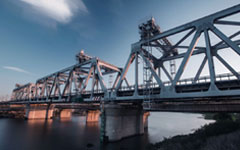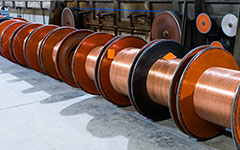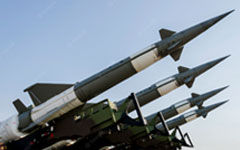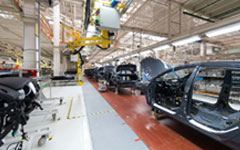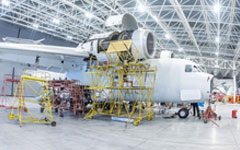
In order to maintain the original performance of the bearing in good condition for as long as possible, it is necessary to maintain and repair it to prevent accidents before they occur, ensure the reliability of operation, and improve productivity and economy.
Maintenance should be carried out regularly according to the operating standards corresponding to the mechanical operating conditions. The content includes monitoring the operating status, replenishing or replacing lubricants, and regular disassembly inspections.
As maintenance items during operation, there are bearing rotation noise, vibration, temperature, lubricant status, etc.
1.1 Bearing maintenance
Bearing cleaning: When disassembling the bearing for maintenance, first record the appearance of the bearing, confirm the remaining amount of lubricant, take a sample of the lubricant for inspection, and then clean the bearing. As cleaning agents, gasoline and kerosene are generally used.
The cleaning of the disassembled bearings is divided into coarse cleaning and fine cleaning. They are placed in containers respectively. First, put a metal mesh pad on the bottom to prevent the bearings from directly contacting the dirt in the container. During rough cleaning, if the bearing is rotated with dirt, it will damage the rolling surface of the bearing, so care should be taken. In the coarse cleaning oil, use a brush to remove grease and sticky matter. After it is roughly clean, switch to fine cleaning. Fine cleaning is to carefully clean the bearing while rotating it in the cleaning oil. In addition, the cleaning oil should also be kept clean frequently.
Bearing maintenance and judgment: In order to judge whether the disassembled bearing can be used, the bearing should be inspected after cleaning. Check the condition of the raceway surface, rolling surface, and mating surface, the wear of the cage, the increase in bearing clearance, and any damage or abnormalities related to the decrease in dimensional accuracy. For non-separable small ball bearings, use one hand to support the inner ring horizontally and rotate the outer ring to confirm whether it is smooth.
For separable bearings such as tapered roller bearings, the rolling elements and raceway surfaces of the outer ring can be inspected separately.
Since large bearings cannot be rotated by hand, pay attention to the appearance of rolling elements, raceway surfaces, cages, rib surfaces, etc. The more important the bearing, the more careful inspection is required.
1.2 Bearing selection
Summary of bearing selection: The market performance requirements of various mechanical devices and instruments using rolling bearings are becoming increasingly stringent, and the conditions and performance required for bearings are also becoming increasingly diversified. In order to select the most suitable bearing from numerous structures and sizes, it is necessary to study from various angles. When selecting bearings, generally, the bearing arrangement, ease of installation and disassembly of the shaft system, the space and size allowed by the bearing, and the marketability of the bearing are generally considered to roughly determine the bearing structure. Next, determine the bearing size while comparing and studying the design life of various machines using the bearing and the various endurance limits of the bearing. When selecting bearings, it is often preferred to only consider the fatigue life of the bearing. The grease life, wear, noise, etc. caused by grease aging also need to be fully studied. Furthermore, according to different uses, it is necessary to select specially designed bearings that meet requirements for accuracy, clearance, cage structure, grease, etc. However, there is no certain sequence or rules for selecting bearings. What should be considered first is the conditions, performance, and most relevant matters required for the bearings, which is especially practical.
○ Required conditions and performance of the bearing ○ Use conditions and environmental conditions ○ Dimensions of the bearing installation part ○ Space allowed for the bearing ○ Size and direction of the load ○ Vibration, impact ○ Rotation speed, limit speed of the bearing
○ Inclination of the inner ring and outer ring ○ Ease of assembly and disassembly ○ Axial fixation and bearing arrangement ○ Noise, torque ○ Rigidity
○ Marketability and economy (determines bearing structure and arrangement) ○ Use of machinery and design life (considering the conditions and performance required for the bearing/the most relevant matters, especially practical) ○ Required conditions and performance of the bearing ○ Conditions of use and environmental conditions ○ Dimensions of the bearing installation part ○ The space allowed by the bearing ○ The size and direction of the load ○ Vibration and impact ○ Rotation speed, the limit speed of the bearing ○ The inclination of the inner and outer rings
○ Axial direction fixation and bearing arrangement ○ Ease of loading and unloading ○ Noise, torque ○ Rigidity ○ Marketality, economy (determining bearing structure, arrangement) ○ Use mechanical and design life ○ Police load or equivalent static load ○ Rotation speed
○ Allowable static load coefficient ○ The temperature difference between the inner and outer ring ○ Rotate speed
○ The tilt of the inner ring and the outer ring ○ Pre -pressure decision (internal) gap ○ Rotating speed ○ Noise
○ Use temperature Decision to maintain the shape of the frame, material ○ Use temperature ○ Rotation speed ○ Lubrication method ○ Sealing method ○ Maintenance and maintenance determines the lubrication method, lubricant, sealing method ○ loading and unloading order ○ workers card mold
○ Dimensions related to installation
Determine dimensions relevant to installation
Decide on loading and unloading method
Bearings and parts around the bearings
Final specifications
1.3 Use of bearings
Precautions for use:
Rolling bearings are precision components and their use must be handled with corresponding caution. No matter how high-performance bearings are used, if used improperly, the expected high performance will not be achieved. Precautions regarding the use of bearings are as follows.
(1) Keep the bearing and its surroundings clean.
Even small dust invisible to the eyes can have a bad impact on the bearings. Therefore, it is necessary to keep the surrounding area clean so that dust does not invade the bearing.
(2) Use with caution.
If the bearing is given a strong impact during use, it will produce scars and indentations, which can become the cause of accidents. In severe cases, cracks and breaks may occur, so care must be taken.
(3) Use appropriate operating tools.
Avoid replacing existing tools and use appropriate tools.
(4) Pay attention to the corrosion of bearings.
When operating bearings, sweat on your hands can cause rust. Be sure to use clean hands and wear gloves if possible.
1.4 Bearing materials
The rings and rolling elements of rolling bearings repeatedly bear high contact pressure while making rolling contact with sliding. The retainer is in sliding contact with both sides of the ferrule and rolling elements, or one side thereof, and bears tensile and compressive forces. Therefore, the materials, performance and main requirements for the bearing rings, rolling elements and cages are as follows:
Required properties of ferrule and rolling element materials: high rolling fatigue strength, high hardness, high wear resistance
Required properties of cage materials: good dimensional stability and high mechanical strength
In addition, good processability is also required. Depending on the application, it is also required to have good impact resistance, heat resistance, and corrosion resistance.
Materials of rings and rolling elements: Rings and rolling elements usually use high-carbon chromium bearing steel. Most bearings use SUJ2 among JIS steel grades. Large bearings use SUJ3.
The chemical composition of SUJ2 has been standardized as a bearing material in various countries around the world. For example: it is the same type of steel as AISL52100 (USA), DIN100Cr6 (West Germany), BS535A99 (UK), etc.
When further impact resistance is required, chromium steel, chromium-molybdenum steel, and nickel-chromium-molybdenum steel are used as bearing materials, and carburizing and quenching are used to make the steel have a hardened layer from the surface to an appropriate depth. Carburized bearings with appropriate hardening depth, fine structure, suitable surface hardness and core hardness have better impact resistance than bearings using bearing steel. The chemical composition of general carburized bearing steel.
NSK has implemented vacuum degassing treatment, so the materials used have high purity, low oxygen content and good quality. Furthermore, appropriate heat treatment is adopted to significantly improve the rolling fatigue life of the bearing.
In addition to the above-mentioned steel types, high-speed steel with excellent heat resistance and stainless steel with good corrosion resistance are also used depending on the special purpose.
Cage material: The material of stamping cage is low carbon steel. Depending on the purpose, brass plates and stainless steel plates are also used. The cage is made of high-strength brass, carbon steel, and synthetic resin.
1.5 Lubrication of bearings
The purpose of bearing lubrication: The purpose of lubrication of rolling bearings is to reduce internal friction and wear of the bearing and prevent burning and sticking. Its lubrication effect is as follows.
(1) Reduce friction and wear.
In the contact parts of the bearing rings, rolling elements and cages, it prevents metal contact and reduces friction and wear.
(2) Extend fatigue life.
The rolling fatigue life of the bearing will be extended if the rolling contact surface is well lubricated during rotation. On the contrary, if the oil viscosity is low and the lubricating oil film thickness is not good, it will shorten.
(3) Discharge friction heat and cool down.
The circulating oil supply method can use oil to dissipate heat generated by friction or heat transmitted from the outside for cooling. Prevent bearings from overheating and lubricating oil itself from aging.
(4) Others
It also has the effect of preventing foreign matter from invading the inside of the bearing, or preventing rust and corrosion.
Lubrication method: The lubrication method of bearings is divided into grease lubrication and oil lubrication. In order for the bearing to function well, first of all, it is necessary to choose a lubrication method suitable for the use conditions and purpose of use. If only lubrication is considered, the lubricity of oil lubrication is dominant. However, grease lubrication has the advantage of simplifying the structure around the bearing. Let’s compare the pros and cons of grease lubrication and oil lubrication.
1.6 Installation of bearings
Whether the bearings are installed correctly affects accuracy, life, and performance. Therefore, the design and assembly departments must fully study the installation of bearings. It is hoped that the installation will be carried out according to the work standards. Projects for work standards typically include the following:
(1) Clean bearings and bearing related parts
(2) Check the size and finishing of related parts
(3) Installation
(4) Inspection after installing the bearings
(5) Supply lubricant
It is hoped that the bearing packaging will be opened just before installation. General grease lubrication, no cleaning, directly filled with grease. Lubricating oil lubrication generally does not need to be cleaned. However, bearings for instruments or high speeds must be washed with clean oil to remove the anti-rust agent coated on the bearings. Bearings with the anti-rust agent removed are prone to rust, so they cannot be left alone. Furthermore, bearings that have been filled with grease cannot be used directly without cleaning.
The installation method of bearings varies depending on the bearing structure, fit, and conditions. Generally, since the shaft rotates mostly, the inner ring requires an interference fit. Cylindrical bore bearings are usually pressed in with a press or hot-fitted. In the case of a tapered hole, install it directly on the tapered shaft, or install it with a sleeve.
When installed into the shell, there is generally a lot of clearance fit and there is interference in the outer ring. It is usually pressed in with a press, or there is also a shrink fit method of installing after cooling. When dry ice is used as the coolant and shrink fit is installed, moisture in the air will condense on the surface of the bearing. Therefore, appropriate rust prevention measures are required.
1.7 Bearing damage
Generally, if bearings are used correctly, they can be used until their fatigue life is reached. However, there may be accidental premature damage and it may not be able to withstand use. This early damage, as opposed to the fatigue life, is the quality limit called failure or accident. Most of them are caused by carelessness in installation, use and lubrication, foreign matter invading from the outside, insufficient research on the thermal effects of the shaft and housing, etc.
Regarding the damage status of bearings, such as: jamming of roller bearing rings and ribs, the reasons can be considered as insufficient and unsuitable lubricant, defects in the oil supply and drainage structure, intrusion of foreign matter, bearing installation errors, and shaft deflection. If the song is too big, these reasons will also overlap.
Therefore, it is difficult to know the real cause of the damage by only investigating the bearing damage. However, if you know the machinery and conditions of use of the bearing, the structure around the bearing, understand the circumstances before and after the accident, and investigate the damage status of the bearing and several causes, you can prevent similar accidents from happening again.


